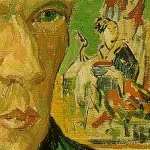
In a post last Saturday I described an outing to the Pont de Clichy to recreate and see for myself some perspectives Van Gogh had when he lived and painted in Paris. After about an hour or so on the banks of the Siene near the Pont de Clichy, I gathered my things, hiked through a small public park behind me (called Parc Robinson) and picked up the Boulevard Voltaire, a street that leads to Asniéres proper. There, I checked a posted map of the area and started sauntering around to see what the city (or what is technically known as a commune) looked and felt like. Eventually I found my way back to Boulevard Voltaire and crossed it to reach the Gabriel Péri Metro station, where I picked up a subway back toward central Paris.
One thing I couldn't help but notice in Asniéres was how new the buildings looked, especially given I had the 19th century in mind as I walked. I actually found it quite hard to imagine how the city would have appeared to Vincent and Bernard. With a few obvious exceptions, most of the buildings looked like there were constructed in the last 50 years, especially the apartment buildings. Many looked quite new, in fact. Unlike central Paris, which in some ways doesn't look that much different from when the Impressionists were painting it, Asniéres is no museum piece. It has the upbeat vigor, the hum, of a young, newly settled, newly arrived area. This may be because many of the residents themselves are new to France, or at least new to Paris. It's the home of significant Persian and Algerian populations--something I picked up from not only peoples' faces but the languages used on flyers and signs. (Although I definitely heard Italian being spoken by a young man and woman who passed me on the sidewalk.) It is a city of immigrants and of burgeoning families. Of kids on scooters, men on motorcycles, and young mothers carrying as much as they can back from the grocery. I thought: If I were a young professional who had just moved to the area and couldn't afford central Paris or Montmartre, this is where I would live. Or if I had only ordinary means and a couple of kids.
When I first arrived, I passed plenty of bars and cafes outside of which brown-skinned men lounged. As I walked on, I saw professional buildings, churches, a public library, a hospital. I saw neighborhoods with apartment buildings and neighborhoods with row houses. Some elegant, some less so. Mostly I noticed that the mood of the area was upbeat and, even for a Sunday morning, the streets were fairly lively. This was due in part to a huge street fair that I eventually walked into as I completed my circuit. The fair was jammed with visitors inspecting booths that featured the normal variety of clothes, scarves, shoes, CDs, food products, and whatnots. I saw some good deals, but what I really noticed was the sense of community. When I left the street fair, I had more or less walked the whole of central Asniéres. I can't say I found out much to explain to me how the place would have looked to Van Gogh. But the working class energy stuck me as being authentic--not just to our time but his.













0 comments:
Post a Comment